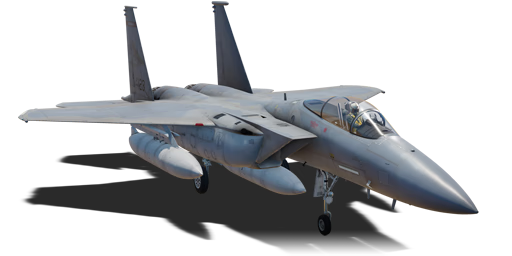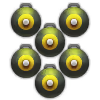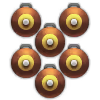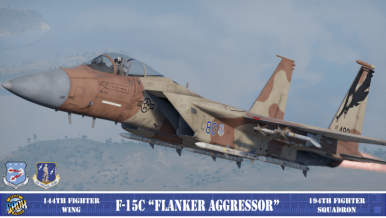



The F-15C MSIP II is a further development of the F-15A, the F-15C being almost impossible to visually distinguish from its earlier predecessor. It was originally intended as a small upgrade to the F-15A, but would go on to be much more. Coming only a few years later, in its initial fit the only major difference was extra fuel, with the same engines, radar, and still no countermeasures. The Multi-Stage Improvement Program (MSIP) II refit in the mid-1980s aimed to rectify that. The F-15C gained access to the AN/APG-63 PSP radar, flares, new engines optimised for high speeds, and the ability to carry conformal fuel tanks to further extend range - all part of MSIP.
Soldiering on through the late '80s and '90s, the F-15C would gain access to the AIM-9M and AMRAAM before receiving two new radars in the early 2000s: the AESA AN/APG-63 (v)2 in late 2000, and the worse AN/APG-63 (v)1 in early 2001. The introduction of the AIM-9X and JHMCS in the early to mid-2000s led to more and more advanced variants of missiles and radars. The F-15C is still in service today, though it is finally in the process of being phased out by the F-15EX after almost five decades of service.
Introduced in Update "Seek & Destroy", the F-15C MSIP II in its mid-2000s variant serves as arguably one of the strongest air supremacy fighters in War Thunder. While its flight performance is marginally worse than the preceding F-15A, the F-15C stands out with its large complement of air-to-air missiles, notably sharing the crown for most ARH missiles at 8 with the F-15J(M) of the Japanese tree. HMD integration also provides the ability to slave both heat-seeking missiles and radar, which is a very useful capability in the fast-paced battles of 4th generation aircraft. The only real downside is the lacking CAS ability with only dumb bombs and 3 TV-guided bombs compared to many of the other fighters of this rank, as the F-15C wasn't intended as a multirole aircraft; that role was filled by the later F-15E Strike Eagle.
flaps
flaps
flaps
brake
| Belt | Belt filling | Armor penetration (mm) at a distance: | |||||
|---|---|---|---|---|---|---|---|
| 10 m | 100 m | 500 m | 1000 m | 1500 m | 2000 m | ||
| HEF-I/API-T/AP-I/SAPHEI | 40 | 36 | 22 | 12 | 6 | 3 | |
| HEF-I/HEF-I/API-T/HEF-I/HEF-I/AP-I | 40 | 36 | 22 | 12 | 6 | 3 | |
| SAPHEI | 37 | 33 | 20 | 11 | 6 | 4 | |
| HEF-I/AP-I/AP-I/SAPHEI | 40 | 36 | 22 | 12 | 6 | 3 | |
| Name | Weight | Slot | ||||||||||||
|---|---|---|---|---|---|---|---|---|---|---|---|---|---|---|
| 84.5 kg |  |  |  |  | ||||||||||
| 84.5 kg |  |  |  |  | ||||||||||
| 147.9 kg |  |  |  |  |  |  |  |  | ||||||
| 240.9 kg |  |  |  | |||||||||||
| 254 kg |  |  |  | |||||||||||
| 6 × | 1,445.4 kg |  |  |  | ||||||||||
| 6 × | 1,524 kg |  |  |  | ||||||||||
| 893.6 kg |  |  |  | |||||||||||
| 1,027 kg |  |  |  | |||||||||||
| 3 × | 1,204.2 kg |  |  |  | ||||||||||
| 253.1 kg |  |  |  | |||||||||||
| 893.6 kg |  |  |  | |||||||||||
| Drop tank (610 gal.) | 145.1 kg |  |  |  | ||||||||||
| 231.3 kg |  |  |  |  | ||||||||||
| 231.3 kg |  |  |  |  | ||||||||||
| 147.9 kg |  |  |  |  | ||||||||||
| Conformal fuel tank | 564 kg |  |  | |||||||||||
| Conformal fuel tank 6 × | 1,271.4 kg |  |  | |||||||||||
| Conformal fuel tank 6 × | 1,393.8 kg |  |  | |||||||||||
| 6 × | 707.4 kg |  |  | |||||||||||
| 6 × | 829.8 kg |  |  | |||||||||||












Flight performance | |
|---|---|
Survivability |
|---|
Weaponry | ||
|---|---|---|
